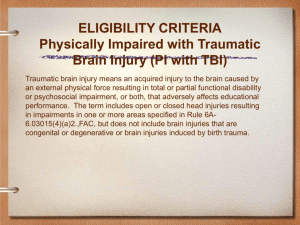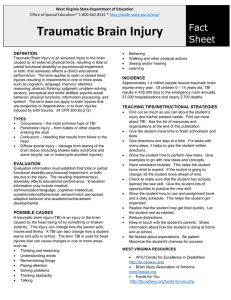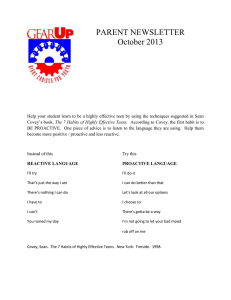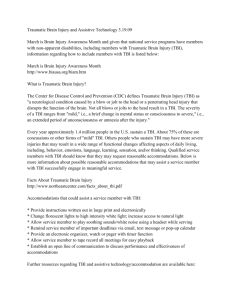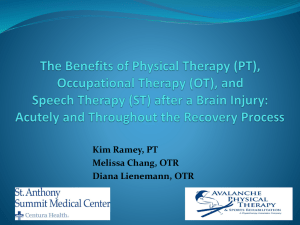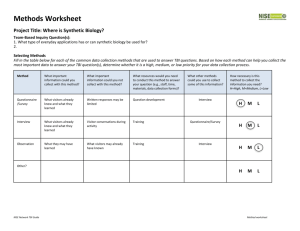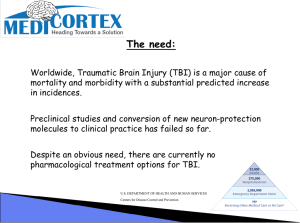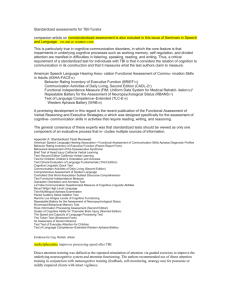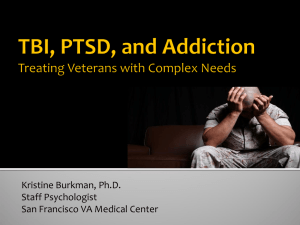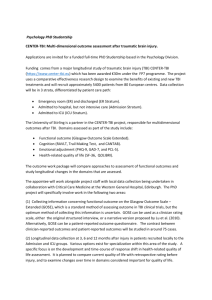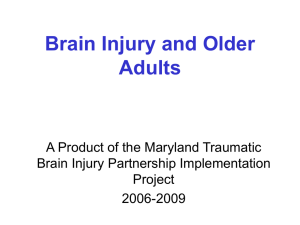TBI.
advertisement
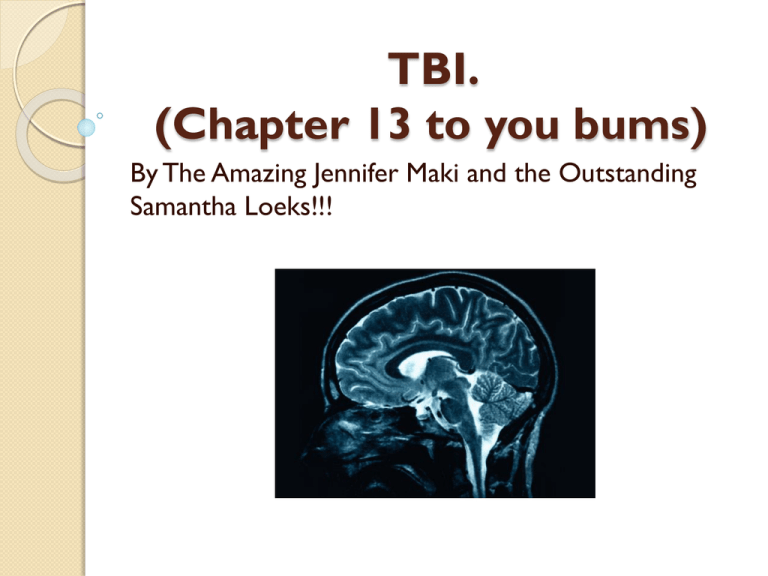
TBI. (Chapter 13 to you bums) By The Amazing Jennifer Maki and the Outstanding Samantha Loeks!!! What is TBI?! TBI stands for traumatic brain injury Specifically… 1. Injury to brain by External force 2. Not caused by degenerative or congenital 3. 4. condition Diminished or altered state of consciousness Neurological or neurobehavioral dysfunction result from injury (followed by impairments in school learning and everyday functioning) More stuff… Occurs after a period of normal neurological development One of the most common injuries in soldiers of the Iraq/Afghanistan wars Typically influences several academic areas simultaneously If you want to get technical… IDEA says… “ an acquired injury to the brain caused by an external physical force, resulting in total or partial functional disability or psychosocial impairment, or both, that adversely affects a child’s educational performance. The term applies to open or closed head injuries resulting in impairments in one or more areas, such as cognition; language; memory; attention; reasoning; abstract thinking; judgment; problem solving; sensory, perceptual, and motor abilities; psychosocial behavior; physical functions; information processing; and speech. The term does not apply to injuries that are congenital or degenerative, or brain injuries induced by birth trauma.” TBI Student Schedule Date: 3/27/01 Morning Schedule Time: Event: To do: 7:30-8:00: Prepare for school (shower, get dressed, eat breakfast) 8:15: Catch bus to school Don’t forget to take lunch and backpack! 8:45: First period: English class— Need to turn in homework Room 201 Mrs. Wilson assignment. Exercises on pages 317-320. 10:00: Second period: Phys Ed.— Need to bring tennis shoes gymnasium Mr. Hall and extra socks 11:15: Third period: Math—Room 315 Need to turn in homework Mrs. Taylor assignment on page 150. Ask for help with problem 21. 12:30 Lunch What causes TBI?! 2 types of head injury 1. Open- penetrating head wounds from something like a gunshot or car accident 2. Closed- internal compression, etc. What is TBI not? Degenerative or congenital conditions ◦ Degenerative: long term, slow deterioration of cells, organs, muscles, etc… ◦ Congenital: condition occurring before birth Injuries induced during birth What does this look like?! Diminished or altered state of consciousness Neurological or Neurobehavioral problems ◦ Can be total or partial disability or psychosocial impairment More specifically, TBI effects areas of… Cognition, language, memory, attention, reasoning Abstract thinking, judgment, problem solving Sensory, perceptual, and motor abilities Information processing, speech, and physical functions Complications… Problems with: ◦ ◦ ◦ ◦ ◦ ◦ ◦ Remembering things Learning new information Sequencing and processing information Manners and social behaviors (humor) Mood swings Depression Progressing at a consistent rate How often do we see TBI?! Well… we aren’t so sure “Hidden disability” or “Silent epidemic” Every year about .5% school age children acquire a TBI, by graduation 4% of students may have one. 15,000-20,000 of those who receive these injuries will have lasting effects Males more prone than females.. Stop showing off! Frequently preventable What can we do to help these people?! Family, peers, and educators need to be prepared to deal with the sometimes dramatic behavioral changes. Kids sometimes don’t realize their behavior has changed. Team approach between parents, special educators, guidance counselor, regular teacher, etc. Help students solve problems in focusing and sustaining attention, remembering previous info, dealing with fatigue, engaging in appropriate social behavior. Hmmm…. http://www.youtube.com/watch?v=O2wlc Vm5mZM IEP…? To decide whether a student needs Special Education, the school talks to the parents, examines medical records, conducts a psychological assessment, and much more It is important that records be kept both pre- and post injury performance Changes must last more than 60 days More IEP things An IEP for a student with TBI usually needs to involve cognitive, social/behavior, and sensorimotor domains. Example… http://www.tbied.org/tbi-support/iepmain/sample-iep-goals/ Students with TBI on IEP need to be continually reassessed If they do not qualify for an IEP, a 504 plan may be instituted Learning Strategies…… Collaboration key! ◦ Work with teachers, aides, parents, student, doctors ◦ Diverse challenges and ranges of disabilities ◦ More people, more problem solving ideas ◦ Pinpoint problems before they appear for the student Problem Solving Questions Is there a problem to solve? What is the problem? How can the problem be solved? Questions continued Which solution or combination is best? Which solution Should be used? Did the plan work? How to implement Solution? Learning Strategies again! Tape recorder, planner, organization devices, memory aids Longer response time Distractions to a minimum Instruction focusing on social aspects of language Praise and encouragement Consistency and predictability Get on your Teacher Caps! Scenario: Julia in your class just got back after a month long absence. While skiing with her family, she careened off a slope hitting her head causing severe brain damage. She is experience severe short term memory loss because of the accident. What can you do to help Julia? Remember the Q’s Is there a problem? *What is the problem? *How can the problem be solved? Which solution sounds best *Which solution should be selected? *How to implement the solution? *Did it work? How do we assess the kiddies?! Keep in mind individual students Hard to separate physiological causes for difficulty with task and from another cause Pinpoint student’s academic and social levels ◦ Team approach vital In the Classroom Break down large assignments into manageable, specific parts Repetition key, especially key points Open ended, multiple choice questions good- independent thinking Use of illustrations and diagrams for harder material Begin class with review, end with class with overview What you can do! Strap the kiddies into the car seats Use common sense Sources Daniel P.Hallahan - James M.Kauffman - Paige C.Pullen - Pearson Boston – 2009 "Guide to Special Education Services." TBI Educator - Brain Injury Education Resources. Teaching Research Institute, 2008. Web. 08 Apr. 2010. <http://www.tbied.org/>.\ Marcus-Keyser, Lori; Briel, Lori; Targett-Sharon,Pam. Enhancing the Schooling of Students with Traumatic Brain Injury. Teaching Exceptional Children. March/April 2002. 4 April 2010. http://www.sbac.edu/~werned/DATA/RESEARCH/journals/Tea ching%20Exceptional%20Children%20JO URNAL/TBI.pdf The Patient Education Institutes. Causes and Effects of TBI. Medline Plus. 5 May 2006. 4 April 2010. ◦ http://www.nlm.nih.gov/medlineplus/tutorials/traumaticbraininjury/htm/ _yes_50_no_0.htm
